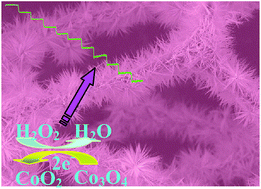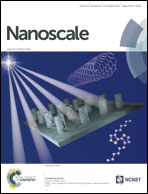Co3O4 nanowires supported on 3D N-doped carbon foam as an electrochemical sensing platform for efficient H2O2 detection†
Abstract
Using a simple hydrothermal procedure and a subsequent annealing treatment, one-dimensional (1D) cobalt oxide nanowires (Co3O4-NWs) with tunable size have been successfully in situ fabricated on a three-dimensional (3D) carbon foam (CF) network. By changing the hydrothermal treatment time (0.5, 1, or 2 h) at 180 °C, size-controlled Co3O4 nanowires can be formed on the CF. Scanning electron microscopy (SEM) and high-resolution transmission electron microscopy (HRTEM) measurements showed that nanoporous Co3O4 nanowires grew uniformly on the 3D carbon framework. Because of the 3D porous architecture and the high conductivity of the carbon foam skeleton, the obtained composites are characterized by fast mass transport, large surface area and high electronic conductivity, which make them very promising electrochemical sensing materials. Among the studied composites, the Co3O4-NWs/CF hydrothermally treated for 1 h exhibited the lowest detection limit (1.4 μM) and the largest linear ranges (0.01–1.4 mM) with a sensitivity of 230 nA μM−1 cm−2 for H2O2 detection. The present study shows that metal oxides supported on 3D carbon materials present a class of promising sensing platform for the electrochemical detection of H2O2.


 Please wait while we load your content...
Please wait while we load your content...